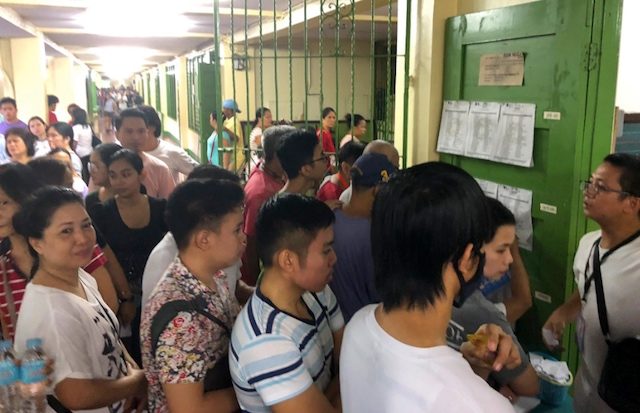SUMMARY
This is AI generated summarization, which may have errors. For context, always refer to the full article.

MANILA, Philippines (UPDATED) – As polls opened across the country on Monday, May 13, the Commission on Elections’ (Comelec) new voter registration verification machines (VRVM) malfunctioned in several precincts, causing voters to wait in line hours before casting their ballots.
Parish Pastoral Council for Responsible Voting Communications Head for San Fernando de Dilao Parish Charles Caluza said 7 of 8 VRVMs in the Celedino Salvador Elementary School in Paco, Manila, were not functioning as of 9:30 am. As early as 5:30 am, teachers reported difficulty logging into the machines.
Teachers – who serve as poll workers on election day – told Rappler the VRVMs did not accept their credentials when they tried to log into the machines before the opening of polls. This caused voting to be delayed, with some precincts opening nearly an hour late.
Some also reported being able to log in though the machine was unable to verify registered voters. Machines malfunctioned soon after, with some indicating voting was done only about 3 hours into the elections. (READ: What voters need to know about Comelec’s fingerprint verification machine)
In total, 7 out of 9 clustered precincts in the polling center – which counted over 6,800 registered voters – reported malfunctioning VRVMs.
Caluza said the poll body advised Board of Election Inspection (BEI) members to instead proceed with manual verification to continue voting.
The Comelec’s VRVMs make use of live fingerprint scanning technology to verify voters in a specific precinct. It it eyed as a way to detect illegal voters and is part of the agency’s efforts to thwart “flying voters” or those who try to vote in more than one precinct.
LOOK: Comelec’s new voter registration verification machines malfunction in 7 of 9 clustered precincts in the Celedono Elementary School in Paco, Manila. Board of election inspector members had to continue with manual verification #PHVote @rapplerdotcom pic.twitter.com/I5Hn9htT35
— Sofia Tomacruz (@sofiatomacruz) May 13, 2019
Meanwhile, at the Epifanio Delos Santos Elementary School, polls opened on time but lines quickly formed outside polling precincts after the Comelec’s VRVMs had a slow start.
Teachers here also reported difficulty starting up machines, which caused voting to be delayed by a few minutes. Long lines were seen snaking outside precincts, with some voters waiting up to an hour to enter and cast their ballots.
“The lesson to be learned here is, kailangan ng mas matinding education tungkol sa mga bagong sistema na ito (there is a need for greater education on this new system)” Comelec spokesperson James Jimenez told reporters in an interview on Monday.
Aside from this, some 8 VRVMs in Moises Padilla town in Negros Occidental also encountered trouble during the first voting hour in some polling precincts.
Moises Padilla election officer Jesus Gaston told reporters that they were waiting for technical support from the poll body to troubleshoot the VRVMs. He added that his office had 5 extra VRVMs to replace the defective ones if needed.
Gaston gave assurances that voters could still vote even without the VRVMs as teachers would check voter’s registration manually should there be problems with the machine.
Jimenez gave assurances that despite the early delays, the election system was working and in full swing.
The Comelec pilot tested the VRVMS in 14 areas including capital Manila, Quezon City, and the Bangsamoro region, among others.
The poll body said if things go smoothly during the VRVMs’ pilot run, it may use the machines nationwide for the 2022 presidential elections.
In the President Corazon Elementary School, several teachers Rappler spoke to also reporter similar problems. Precincts, they said, opened at around 6:30 am after several attempts to start the VRVM.
Meanwhile, in precincts where the machine was working, teachers reported delays in the processing of fingerprints with some opting to do manual verification instead. A teacher in the Corazon Elementary School said checking voters’ identity manually was faster than having to use the machine, and with thousands of voters lined up outside the classroom’s doors, they couldn’t afford to waste time.
In other parts of the country, vote-counting machines encountered some technical problems too, temporarily stalling the voting process. (READ: Election 2019 technical issues: Paper jams, malfunctioning machines) – with a report from Marchel Espina/Rappler.com
Follow Rappler’s full coverage of the 2019 Philippine elections here.
Bookmark this Rappler page for real-time election results.
It will go live as soon as precincts close at 6 pm Monday, May 13.
Add a comment
How does this make you feel?
There are no comments yet. Add your comment to start the conversation.